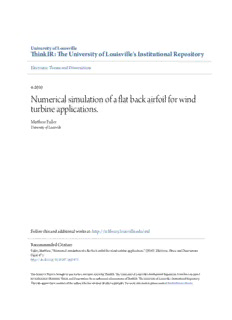Table Of ContentUUnniivveerrssiittyy ooff LLoouuiissvviillllee
TThhiinnkkIIRR:: TThhee UUnniivveerrssiittyy ooff LLoouuiissvviillllee''ss IInnssttiittuuttiioonnaall RReeppoossiittoorryy
Electronic Theses and Dissertations
4-2010
NNuummeerriiccaall ssiimmuullaattiioonn ooff aa flflaatt bbaacckk aaiirrffooiill ffoorr wwiinndd ttuurrbbiinnee
aapppplliiccaattiioonnss..
Matthew Fuller
University of Louisville
Follow this and additional works at: https://ir.library.louisville.edu/etd
RReeccoommmmeennddeedd CCiittaattiioonn
Fuller, Matthew, "Numerical simulation of a flat back airfoil for wind turbine applications." (2010).
Electronic Theses and Dissertations. Paper 471.
https://doi.org/10.18297/etd/471
This Master's Thesis is brought to you for free and open access by ThinkIR: The University of Louisville's Institutional
Repository. It has been accepted for inclusion in Electronic Theses and Dissertations by an authorized administrator
of ThinkIR: The University of Louisville's Institutional Repository. This title appears here courtesy of the author, who
has retained all other copyrights. For more information, please contact [email protected].
NUMERICAL SIMULATION OF A FLAT BACK AIRFOIL FOR WIND TURBINE
APPLICATIONS
By
Matthew Fuller
B.S. Eng., University of Louisville, 2009
A Thesis
Submitted to the Faculty of the
University of Louisville
J.B. Speed School of Engineering
in Partial Fulfillment of the Requirements
for the Professional Degree
MASTER OF ENGINEERING
Department of Mechanical Engineering
April 2010
NUMERICAL SIMULATION OF A FLAT BACK AIRFOIL FOR WIND TURBINE
APPLICATIONS
Submitted by:__________________________________
Matthew Fuller
A Thesis Approved On
___________________________________
(Date)
by the Following Reader and Examination Committee:
___________________________________
Dr. Yongsheng Lian, Thesis Director
___________________________________
Dr. R. Eric Berson
___________________________________
Dr. Geoffrey Cobourn
ii
ACKNOWLEDGEMENTS
The author would like to thank his advisor Dr. Yongsheng Lian for all the guidance
and tutelage in learning the CFD process, defining clear project goals, and preparing this
report.
iii
ABSTRACT
Wind energy provides an attractive power source as an alternative to fossil fuels
because it is abundant, clean, and produces no harmful emissions. To extract more
energy from the wind we need to increase the wind turbine size. However, the increase
in size has begun to reach a limit in terms of material composition and structural stability.
To quell the trend of increasing size in wind power systems alternative wind turbine
blade designs are investigated and evaluated to increase power production and efficiency
of present size machines. Flat back airfoils have been proposed for the inboard region of
large wind turbine blades because they provide structural and aerodynamic advantages.
In this work we will investigate the aerodynamic performance of flat back airfoils with
computational fluid dynamics techniques. To reduce the drag and noise inherent from the
blunt trailing edge, a splitter plate with varying lengths is added to the trailing edge of the
airfoils. Comparisons are made with experimental data. Excellent agreement is achieved
with the measurements. Our numerical simulations show that the flat back airfoil can
increase lift production as much as 20%. The splitter can effectively reduce drag by as
much as 20% and tonal noise by as much as 20 dB.
iv
TABLE OF CONTENTS
Page
APPROVAL PAGE .............................................................................................................ii
ACKNOWLEDGEMENTS................................................................................................iii
ABSTRACT........................................................................................................................iv
NOMENCLATURE ...........................................................................................................vi
LIST OF TABLES .............................................................................................................vii
LIST OF FIGURES ..........................................................................................................viii
I. INTRODUCTION ............................................................................................1
A. Background...........................................................................................1
B. Literature Review .................................................................................4
C. Objectives ...........................................................................................11
II. PROCEDURE ................................................................................................13
A. Numerical Method ..............................................................................13
III. RESULTS AND DISCUSSION.....................................................................19
A. A Flat back Airfoil Simulation ...........................................................19
B. Study of Trailing Edge Thickness ......................................................31
C. Study of Trailing Edge Modifications ................................................36
D. Study of Aerodynamically Induced Noise..........................................43
IV. CONCLUSIONS ............................................................................................46
APPENDIX I......................................................................................................................49
APPENDIX II ....................................................................................................................50
REFERENCES ..................................................................................................................51
VITA ..................................................................................................................................53
v
NOMENCLATURE
Farfield = Free stream of fluid simulation domain
C = Chord length of airfoil
Y+ = Non dimensional distance for wall bounded flow
vi
LIST OF TABLES
Page
TABLE I ........................................................................................................................... 23
TABLE II .......................................................................................................................... 24
TABLE III ......................................................................................................................... 25
TABLE IV ........................................................................................................................ 26
TABLE V .......................................................................................................................... 28
vii
LIST OF FIGURES
Page
FIGURE 1 - Horizontal axis wind turbine .......................................................................... 4
FIGURE 2 - HAWT size to power relationship (van Dam, 2009) ..................................... 6
FIGURE 3 - Examples of wind turbine blade sections (Griffith, 2009) ............................. 7
FIGURE 4 - Blunt trailing edge airfoil geometry (Berg et al, 2008) ................................. 9
FIGURE 5 - Lower trailing edge vortex formation (van Dam 2009) ............................... 10
FIGURE 6 - TU Delft DU 97-W-300 blunt trailing edge airfoil ...................................... 16
FIGURE 7 - Fluent boundary conditions for fluid simulation .......................................... 18
FIGURE 8 - Fully unstructured fluid domain mesh ......................................................... 20
FIGURE 9 - Detail view of fully unstructured airfoil mesh ............................................. 20
FIGURE 10 - Hybrid grid discretizing fluid domain ........................................................ 22
FIGURE 11 - Structured grid circumferential spacing sensitivity mesh .......................... 23
FIGURE 12 - Coefficient of lift versus angle of attack two equation model ................... 26
FIGURE 13 - Two and three equation k-ω model lift coefficient comparison ................ 27
FIGURE 14 - Vorticity contours, a. Unstructured grid/turbulent scheme, b. Unstructured
grid/transition scheme, c. Hybrid grid/turbulent scheme, d. Hybrid grid/transition scheme,
6.18 AOA .......................................................................................................................... 29
FIGURE 15 - Airfoil surface coefficient of pressure values numerical vs. experimental,
three equation model, 6.18 AOA ...................................................................................... 30
FIGURE 16 - Unstructured mesh for airfoil trailing edge width 10% of chord ............... 32
FIGURE 17 - Airfoil trailing edge thickness lift coefficient comparison ........................ 32
FIGURE 18 - Lift-drag polar plot for 1.74% C and 10% C trailing edge thickness, 2-10
degree AOA ...................................................................................................................... 33
FIGURE 19 - Instantaneous vorticity contours for 10% C trailing edge thickness airfoil,
6.18 AOA .......................................................................................................................... 35
FIGURE 20 - Airfoil surface coefficient of pressure values 1.74% C vs. 10% C trailing
edge thickness, 6.18 AOA ................................................................................................ 35
viii
Description:To quell the trend of increasing size in wind power systems alternative wind turbine computational fluid dynamics techniques. To reduce the drag

